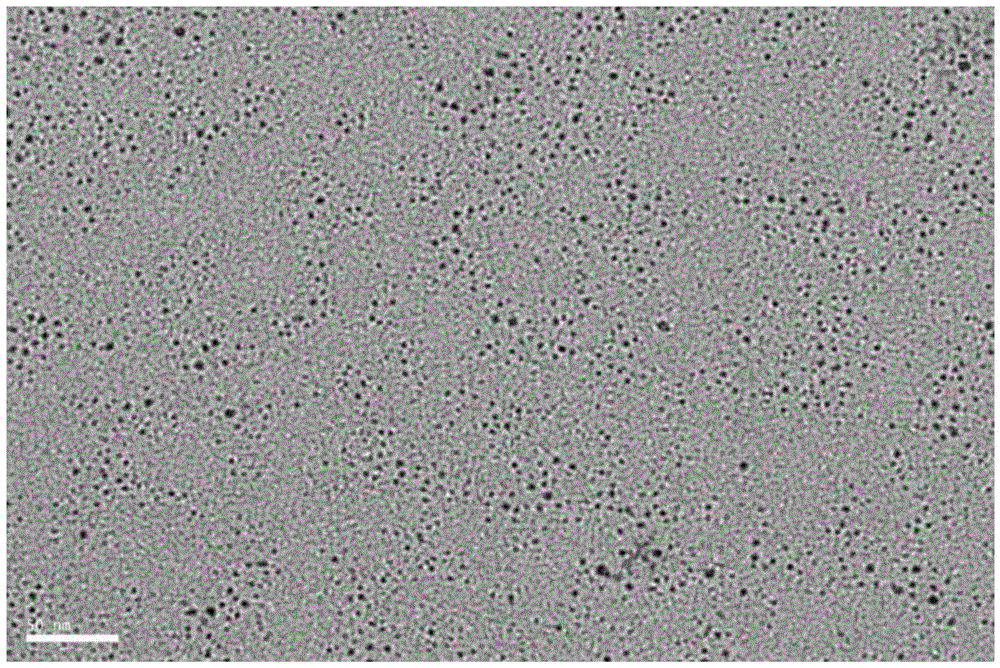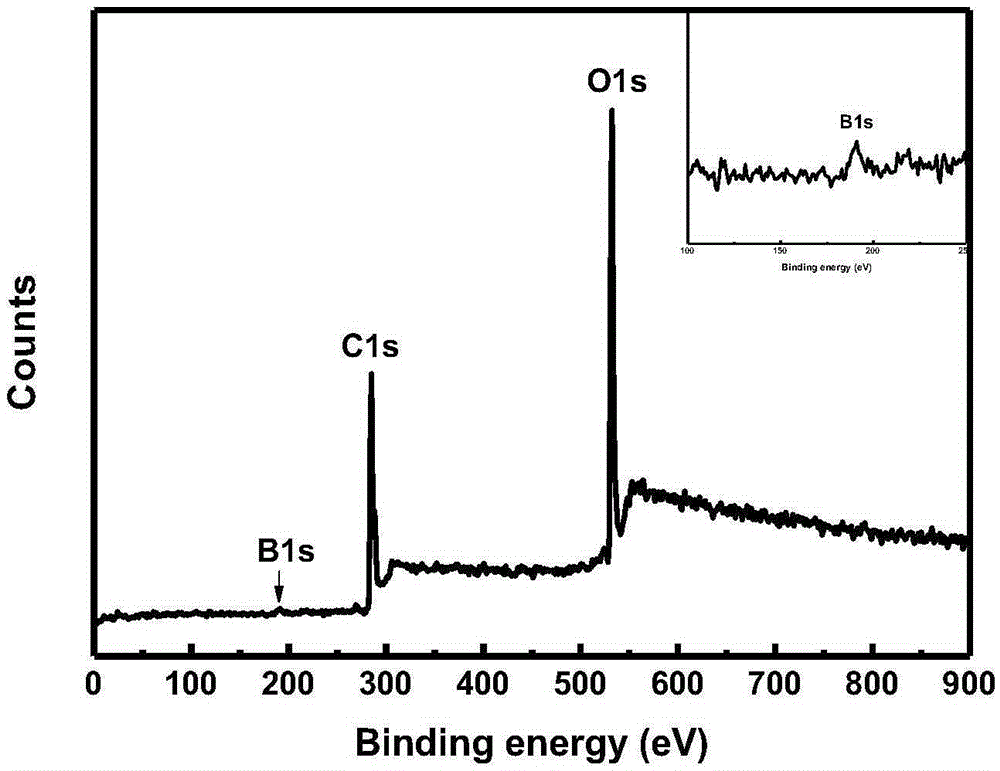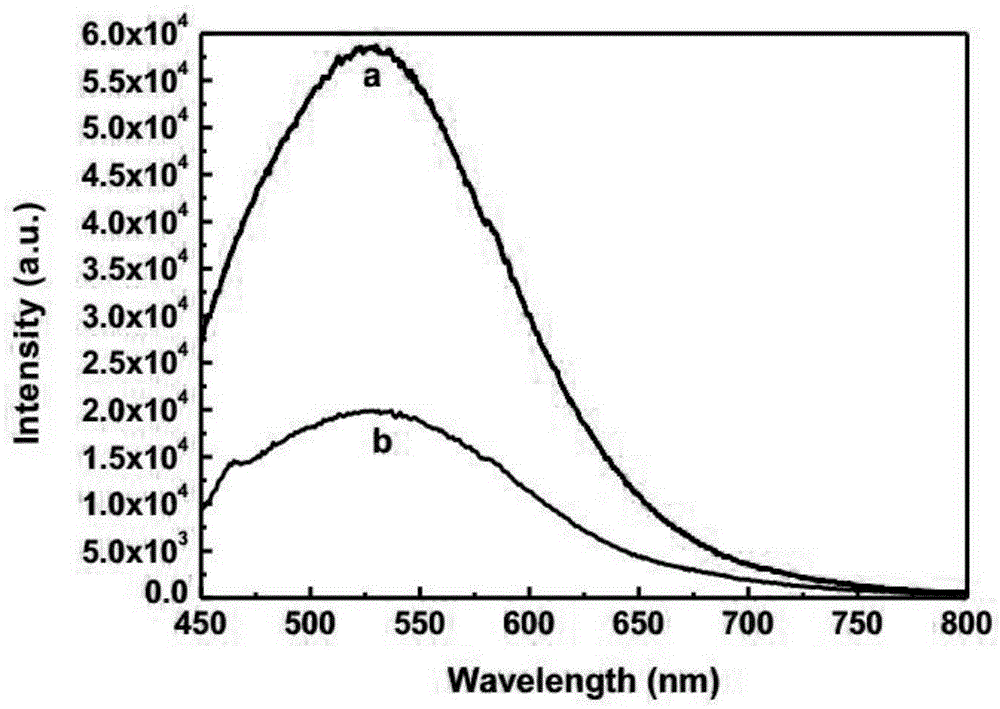Detection method for heme based on boron-doped grapheme quantum dots fluorescence quenching effect
A graphene quantum dot and fluorescence quenching technology, which is applied in the field of bioluminescence detection, can solve the problems of reagent biotoxicity, unstable measurement, and complicated operation, and achieve the effects of low cost, strong optical anti-interference ability, and simple operation
- Summary
- Abstract
- Description
- Claims
- Application Information
AI Technical Summary
Problems solved by technology
Method used
Image
Examples
Embodiment 1B
[0032] Embodiment 1B-GQDs preparation and solution preparation
[0033] 1. Preparation of boron-doped graphene quantum dots
[0034] Boron-doped graphene quantum dots (B-GQDs) were synthesized by potentiostatic chronoamperometry via an electrochemical workstation (CHI660B). The specific method is: prepare 0.1mol / L borax aqueous solution, and take 20mL as electrolyte. A high-purity graphite rod was used as the working electrode, a platinum wire electrode was used as the counter electrode, and a calomel electrode was used as the reference electrode, and the working potential was 3V. After reacting for 2 hours, the solution was filtered through a 0.22 μm filter membrane to remove graphene sheets. Dialyze through a 3500Da dialysis bag to remove Na from the solution + and B 4 o 7 2- , to get B-GQDs.
[0035] 2. Prepare boron-doped graphene quantum dot solution: disperse the above-mentioned synthetic B-GQDs in phosphate buffer (concentration is 0.1mol / L, pH value is 7.4) to o...
Embodiment 2B
[0037] Embodiment 2B-GQDs fluorescence performance evaluation
[0038] The fluorescent performance of B-GQDs solution was detected by fluorescence spectrometer; the excitation wavelength was 380nm, and the emission wavelength was 530nm.
[0039] The quantum dot solution prepared in Example 1 was diluted with phosphate buffer (0.1 mol / L, pH 7.4) until the B-GQDs concentration was 15 μg / mL, and the fluorescence spectrum of the solution was detected;
[0040]Take a certain amount of the quantum dot solution prepared in Example 1 and mix it with the heme solution, add phosphate buffer (concentration is 0.1mol / L, pH value is 7.4) to dilute to obtain a mixed solution; wherein the concentration of B-GQDs is 15 μg / mL , the hemoglobin concentration was 1000 μmol / L. The fluorescence spectrum of the mixed solution was detected by a fluorescence spectrometer.
[0041] like image 3 As shown, curve a in the figure is the fluorescence signal of the B-GQDs blank sample without heme, and b...
Embodiment 3
[0042] Embodiment 3 establishes the working curve of B-GQDs detection hemoglobin concentration
[0043] Take a certain amount of quantum dot solution and heme solution prepared in Example 1, mix and add phosphate buffer (concentration is 0.1mol / L, pH value is 7.4) to dilute, and prepare a group of samples including blank standard sample. Standard solutions with different hemoglobin concentrations; the concentration of B-GQDs is 15 μg / mL, the hemoglobin concentration of the blank standard sample is 0 μmol / L, and the hemoglobin concentration of other standard solutions is 10-1000 μmol / L; a series of different concentrations are detected by fluorescence spectrometer Fluorescence signals of standard solutions of heme and B-GQDs (15 μg / mL), such as Figure 4 As shown, the a-n hemoglobin concentrations are 0μmol / L, 10μmol / L, 50μmol / L, 100μmol / L, 150μmol / L, 200μmol / L, 300μmol / L, 400μmol / L, 600μmol / L, 800μmol / L, 1000μmol / L, 1200μmol / L, 1400μmol / L, 1500μmol / L.
[0044] The response s...
PUM
| Property | Measurement | Unit |
|---|---|---|
| Particle size | aaaaa | aaaaa |
Abstract
Description
Claims
Application Information
 Login to View More
Login to View More - R&D
- Intellectual Property
- Life Sciences
- Materials
- Tech Scout
- Unparalleled Data Quality
- Higher Quality Content
- 60% Fewer Hallucinations
Browse by: Latest US Patents, China's latest patents, Technical Efficacy Thesaurus, Application Domain, Technology Topic, Popular Technical Reports.
© 2025 PatSnap. All rights reserved.Legal|Privacy policy|Modern Slavery Act Transparency Statement|Sitemap|About US| Contact US: help@patsnap.com



